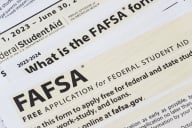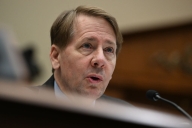You have /5 articles left.
Sign up for a free account or log in.

Anchiy/Getty Images
Much has been written about the Great Resignation. The sheer scale is obvious: about 25 million workers left their jobs in the second half of 2021 alone. More ambiguous is the downstream impact on the labor markets: Where will people choose to work, how will they prefer to work (remote or in-person) and what will employers do to balance their own needs with the shifting demands of employees?
Likewise, higher education’s “great interruption” (our term) has been seismic. The decline in straight–from–high school–to–college enrollment and the uptick in stop outs—already enrolled students hitting the pause button on their educations—has accelerated since the start of the pandemic. According to the National Student Clearinghouse Research Center, undergraduate enrollment year over year fell by 3.6 percent in fall 2020 and by 3.1 percent in fall 2021. Total undergraduate enrollment declined 6.6 percent from fall 2019 to fall 2021, representing a loss of just over a million students.
In fall 2020, 20.7 percent fewer students than in 2019 enrolled directly in college from high school, and more than one in four students enrolled in college in 2019 did not return the following fall, the highest rate since 2012. As in so many spheres of life, COVID is having an accelerated impact on already concerning trends. For higher education, these sober statistics are acute signals of a decade-long enrollment decline of 13 percent. And with the number of high school graduates projected to decrease from 2027 through 2037, college enrollment challenges have just begun.
Higher education leaders have not been blind to the long-term enrollment trends, but more than a few seem to lack a bold vision of future change, instead choosing to believe that their institutions will be outliers and somehow thrive. Certainly, the declining numbers have not impacted all sectors uniformly. Since fall 2020, community colleges have taken the biggest hit but, according to NSCRC, in 2021 half of the decline in college enrollments from the previous year was accounted for by four-year colleges. And, of course, the media reminds us that for both private and public elite institutions, the last two admission cycles have been banner years. The NSCRC data starkly contrast enrollment trends by selectivity—less selective four-year colleges are getting hammered. The great interruption has baldly exposed very concerning trends in the higher education student enrollment market.
As suggested by the sharp decline in community college enrollments, low-income students have been disproportionally diverted from the college pathway. Over the last two cycles, Free Application for Federal Student Aid submissions have declined significantly and especially among students attending low-income high schools. In no racial or ethnic group is this decline more evident than among Hispanic students, with a decline of 7 percent in undergraduate enrollment from 2019 to 2021. These are disturbing trends for our nation and for colleges that expected the rapidly declining white demographic to be buoyed by increasing Hispanic cohorts.
Long a concern for higher education, male enrollments continued to perform poorly in the pandemic years, declining by 10.2 percent between fall 2019 and fall 2021 compared to a 6.8 percent drop for women. As cited in a Wall Street Journal article, “in the next few years, two women will earn a college degree for every man, if the trend continues.”
It is entirely likely that the roiling pandemic economy and labor market have exacerbated the male crisis in higher education. The Washington Post observed that “an analysis of enrollment trends, survey data and similar signals show ‘education for the skilled trades appears to be returning to fashion.’” The article cited a survey that found only 48 percent of high school students polled in September 2021 were interested in going on to college directly from high school, compared to 71 percent as recently as May 2020. Another study connected the dots between men and skilled labor when it observed, “more men than women dropped out of college during the pandemic because men were overrepresented in fields where hands-on work is essential.”
Then there is the elephant in the room: the rising cost of higher education and its return on investment. Doug Shapiro, executive director of NSCRC, reflected on the pandemic enrollment trends: “The phenomenon of students sitting out of college seems to be more widespread. It’s not just the community colleges anymore. That could be the beginning of a whole generation of students rethinking the value of college itself.”
In its 2021 annual survey of college graduates, the Strada Education Network found that only half of its respondents believed their college degree was worth the cost. And likely to add more doubt about the value of college among low-income families, a recent study from Georgetown University found that about one-third of the colleges examined had a majority of former students earning less than high school graduates, predominately because of low completion rates at those schools.
Even before the pandemic’s onset, there was a growing distrust of higher education. According to a Pew Research Center survey in fall 2019, “only half of American adults think colleges and universities are having a positive effect on the way things are going in the country these days. About four-in-ten (38 percent) say they are having a negative impact—up from 26 percent in 2012.” Consistent with the political polarization acerbated by COVID, the uptick in “negative impact” is almost entirely accounted for by registered Republicans, according to the Pew study. The perception that colleges are monolithically left-leaning in their teaching is likely to a have broader negative influence across the political spectrum. Even College Confidential threads stitch a cynical fabric of colleges being a good fit, or not, for students based on the political leanings of their states.
Like the Great Resignation, the great interruption has been of epic scale and raises serious questions about the future of higher education as we know it. But it is not melodramatic to conclude that for far too many colleges and universities, the collateral damage of the great interruption will be significant. If the behavioral patterns—declining enrollments of low-income students, Hispanics and men, as well as growing skepticism of college value and pedagogy—persist after the pandemic become endemic, the pressures on enrollment and revenue will mount well before the demographic cliff of the 2030s.
There is a general self-congratulatory spirit among higher education leaders that they effectively pivoted operations in addressing COVID-19 impacts. Now, the more daunting challenge for all of higher education is to think creatively and boldly about how colleges and universities need to adapt in the long run. Assuming current college seats (supply) remain unchanged, the supply will far outstrip the number of students (demand) seeking them over the next 15 years. How will your institution appeal to and be valued by a larger percentage of a declining number of prospective students with diverse needs? The time to strategically address this critical question is now.








